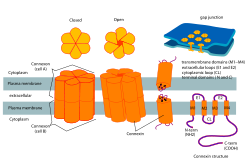- Connexon
-
Connexon 
Connexon and connexin structure Latin connexona Code TH H1.00.01.1.02025 In biology, a connexon is an assembly of six proteins called connexins that can be a part of a gap junction channel between the cytoplasm of two adjacent cells. The connexon is actually the hemichannel supplied by a cell on one side of the junction; two connexons from opposing cells normally come together to form the complete intercellular gap junction channel. However, in some cells, the hemichannel itself is active as a conduit between the cytoplasm and the extracellular space.
References
Further reading
- Andrew L Harris and Darren Locke (2009). Connexins, A Guide. New York: Springer. pp. 574. ISBN 978-1-934115-46-6. http://www.springer.com/978-1-934115-46-6.
Histology: Epithelial proteins (TH H1.00.01.1) Lateral/cell-cell Cell adhesion molecules: Adherens junction (Cadherin) · Desmosome (Desmoglein)
Ion channels: Gap junction/Connexon (Connexin)
Cytoskeleton: Desmosome (Desmoplakin, Plakoglobin, Tonofibril)
other membrane proteins: Tight junction (Claudin, Occludin, MARVELD2)Basal/cell-matrix Apical B strc: edmb (perx), skel (ctrs), epit, cili, mito, nucl (chro) Categories:- Biochemistry stubs
- Membrane biology
Wikimedia Foundation. 2010.
